How to Plan an IELTS Writing Task 2 Essay in 5 Minutes – A Step-by-Step Guide
You have 40 minutes to read the question, plan your answer, write the essay, and check your work for IELTS Writing Task 2. It can be tempting to start writing immediately, but spending just a few minutes planning can make a huge difference. In fact, experienced IELTS tutors note that top-scoring students always spend time planning before they write. Planning helps you organize your ideas, structure your essay clearly, and use your time efficiently, ultimately improving coherence and task achievement. A well-planned essay flows logically, stays on topic, and addresses all parts of the question – which is exactly what the examiner wants.
What you’ll learn:
- Why planning is important for IELTS essays (and how it affects your score)
- A simple 5-minute step-by-step planning process
- How to break down any Task 2 question and identify what it asks
- Sample plans for each main essay type (opinion, discussion, etc.)
- Common planning mistakes to avoid
By following this guide, you’ll gain confidence and speed. You’ll see that good essays start with a clear plan, building structure and purpose that make your writing stronger. Let’s dive in!
Why You Need to Plan Before Writing
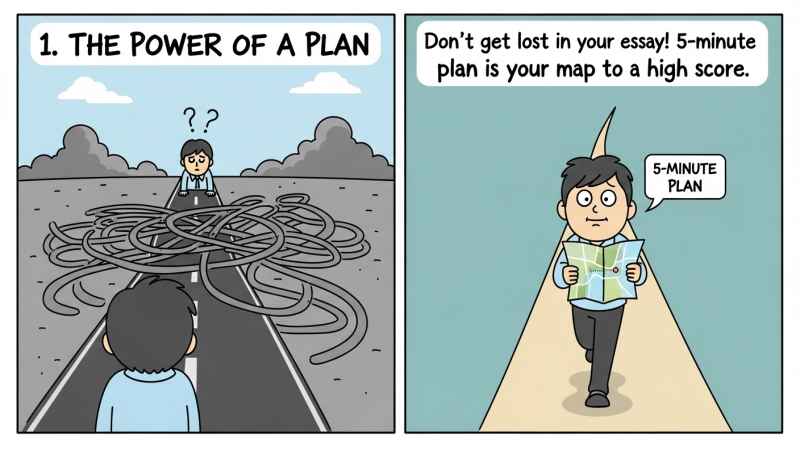
Image: A student writing at a desk (planning an essay can make your writing faster and more organized)
Spending 5 minutes planning your essay is not wasted time – it’s an investment that pays off in your score. In IELTS Writing, roughly 50% of your marks come from Coherence and Cohesion and Task Achievement. In other words, how well you structure your ideas, stay on topic, and fully answer the question counts for half your score. A strong plan ensures your essay has a logical flow and addresses all parts of the task. For example, IELTS Advantage explains that planning “helps you organise your ideas and structure your essay” which saves time and results in a “clear and coherent essay”. Even the British Council advises spending about 5 minutes “thinking of ideas and planning your work” before writing.
Here are some key benefits of planning:
- Stay on topic: A plan keeps your writing focused. You list the points that directly answer the question, so you avoid irrelevant ideas or rabbit trails.
- Organize logically: By outlining the order of your points, you make sure each idea flows to the next. This logical sequence makes the essay easier to follow.
- Use varied language: Planning lets you note down synonyms and linking words in advance, so you can avoid awkward repetition and connect your ideas smoothly.
- Write faster and with confidence: When you know what you’re going to say, the writing comes more quickly. You spend less time thinking about what to write and more on writing it well. IELTS Jacky points out that without a plan, writing an essay “is like going on a journey without a map,” but “spending a few minutes planning your essay will give you an easy to follow map from your introduction to your conclusion”.
Remember: an essay with perfect grammar can still score low if it lacks structure. As the original IELTS rubric shows, good grammar and vocabulary alone aren’t enough if your ideas are jumbled or you miss parts of the question. Many students with excellent English languaging end up with Band 5 or 6 simply because they didn’t plan. So plan first, then write. It will help you write a more coherent, relevant, and complete essay.
Now, let’s put planning into practice with a quick 5-minute routine. Follow these simple steps, timing yourself as indicated (these times are a guideline):
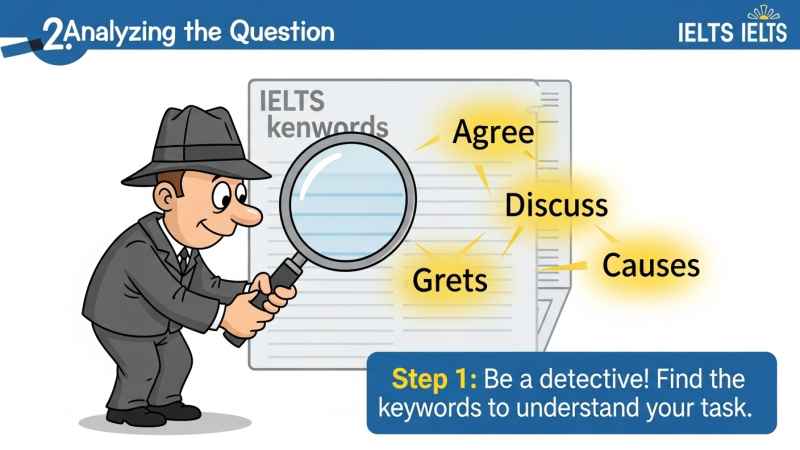
Step 1: Look over the question (1 minute).
- Read the prompt carefully and identify the task type (Opinion, Discussion, Problem-Solution, Advantages/Disadvantages, or Double Question).
- Highlight or underline key words, phrases, and instructions in the question. Focus on topic words and instruction words. For example, in “Some people believe that fast food should be banned by the government to make people healthier. Do you agree or disagree?”, the topic is fast food ban, and the instructions are “Do you agree or disagree?”.
- Make sure you understand what the question asks. If it’s an opinion question (“agree/disagree”), know that you must take a clear side. If it’s discussion (“both views”), know to cover both opinions. IELTS Advantage emphasizes analyzing the question by identifying its type and keywords.
Example:
- For the question “Some people say college should focus on job skills, while others say it should focus on personal growth. Discuss both views and give your opinion.”
- Type: Discussion essay (two views).
- We’ll need to mention both views, then state our own view.
Step 2: Choose your position (0.5 minutes).
- For opinion or discussion essays, decide your stance or main idea immediately. Even if you have mixed feelings, choose the position that you can argue best. (Remember, you’re writing an essay, not a personal diary – feel free to pick the side with stronger points.)
- Don’t try to stay neutral. If it’s an opinion question, say “I agree” or “I disagree” in your introduction, so the examiner sees your position clearly. IELTS tutors advise picking a side right away.
- Jot down a quick note of your chosen opinion. This becomes your thesis.
Example:
- For the fast food ban question above, you might decide “I don’t agree with banning fast food. I believe it’s better to educate people and provide healthy choices.” This is your stance.
Step 3: Come up with two main ideas (1 minute).
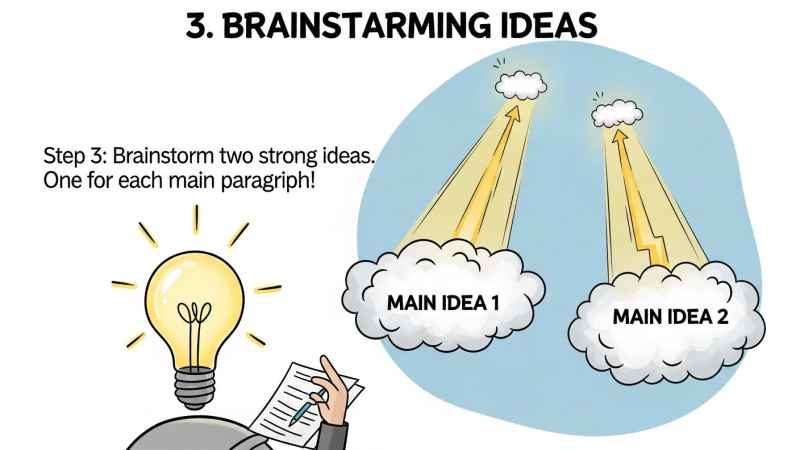
Image: A student outdoors making notes (brainstorming ideas for the essay).
With your position in mind, brainstorm two strong reasons to support it. These will be the main ideas of your two body paragraphs. Focus on one idea per paragraph, and think of a specific supporting example for each idea.
- Write down two bullet points for Body 1 and Body 2. Each bullet will have: one main idea, plus a brief hint of why it’s true or an example.
- Use simple notes or keywords – you just need the gist. Later you’ll expand these into full sentences.
- Ensure each idea clearly links to your position. If you’re “Agree” with banning fast food, maybe ideas like “banning ensures fewer unhealthy options”; if “Disagree”, maybe ideas like “bans limit freedom” and “education is better”.
IELTS Jacky stresses that part of planning is generating relevant ideas so you fully answer the question. For example, a lack of good ideas leads to poor Task Achievement.
Example:
- If you took the stance “I don’t agree with banning fast food”, your two body-ideas might be:
- Personal Freedom: Banning fast food would go against individual rights and choice (people can choose what to eat).
- Better Solutions Exist: Focusing on education and labeling is more effective (e.g., teaching nutrition, using traffic-light food labels in the UK).
Each idea should be clear enough that you can explain why it matters and give an example. For instance, under “Personal Freedom,” you might note “people will just eat other unhealthy foods” as support.
Step 4: Plan the structure of your paragraphs (1.5 minutes).
Draft a very simple outline of your essay’s structure. This ensures you know exactly what you will write, sentence by sentence. Use the standard IELTS essay format: Introduction, Body 1, Body 2, Conclusion.
- Introduction: Paraphrase the question in your own words and state your position or the main idea. This shows you understand the task.
- Body Paragraph 1: Write your first main reason (from Step 3), explain it, and give an example.
- Body Paragraph 2: Write the second reason, explain it, and give an example.
- Conclusion: Summarize your position again (don’t introduce new ideas). Restate your thesis in different words and highlight the key reasons.
For example, following our fast-food topic, your outline notes might look like this:
- Introduction: Paraphrase question + thesis (e.g., “Banning fast food is not the best approach; instead, education is preferable.”).
- Body 1 (Reason 1): Limits freedom. Explain that people will find other unhealthy options anyway (snacks, junk food) if fast food is banned. Example: sugary drinks and processed snacks are still available in vending machines, so banning only one source doesn’t stop obesity.
- Body 2 (Reason 2): Education and labeling are better. Explain that teaching nutrition or clear food labels helps people make healthier choices. Example: the UK’s traffic light food-label system helps consumers choose healthier products.
- Conclusion: Reaffirm that education (not bans) is the best solution, accepting people’s choices.
Such a plan (like a mini-script) gives you a roadmap. IELTS Jacky even likens an essay plan to a map of your journey. With this outline, you can write quickly and coherently: each paragraph has a clear topic and progression.
Step 5: Write down key words and phrases (1 minute).
Quickly note 3–5 keywords or short phrases for the topic. These remind you of the main concepts. Also jot synonyms and linking words so your essay reads more fluently.
- Keywords: Essential terms or ideas (e.g., obesity, processed food, nutrition, healthy diet, public awareness).
- Synonyms: For each key word, write a synonym to avoid repetition (e.g., fast food = junk food; teacher = educator; help = assist).
- Linking words/phrases: Transitional words to connect ideas, like for example, furthermore, however, on the other hand, as a result, in conclusion.
For instance, in the fast-food essay you might list: obesity; unhealthy diets; nutrition as keywords; synonyms junk food, processed food; and connectors like for example, on the one hand, because of, to sum up. Having these in front of you saves time during writing. It also reminds you to paraphrase the question (never copy the question word-for-word in your essay).
More Planning Examples by Essay Type
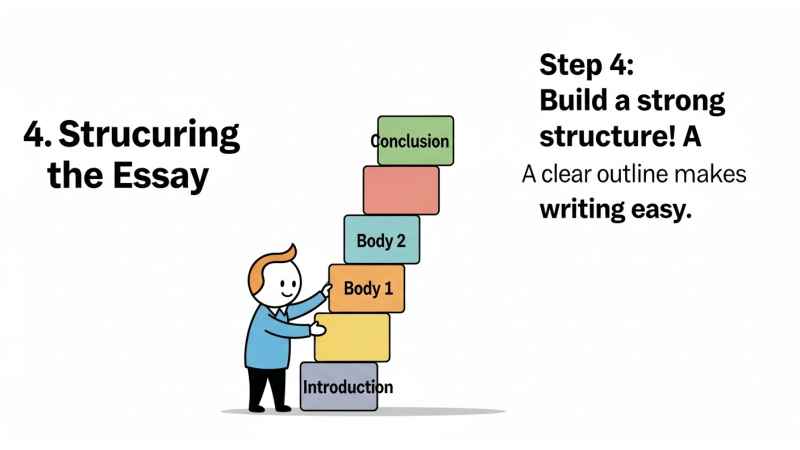
Depending on the Task 2 prompt, you’ll use a slightly different approach. Here are sample plans for each common essay type:
Opinion Essay
For an opinion (agree/disagree) question, decide your stance and give reasons.
- Question: “Working from home is better than working in an office.”
- Plan:
- Position: Agree (you believe working from home has advantages).
- Reason 1: Saves time and money (e.g., no commute – some people save up to 2 hours per day).
- Reason 2: Better work-life balance (flexible schedule; easier childcare).
- Conclusion: Strongly agree, as it’s efficient and employee-friendly.
Explanation: You would write an introduction stating you agree, then each body paragraph expands one reason with details and an example (like research or anecdote about productivity). Finally, conclude by summarizing that home offices offer clear benefits. This mirrors the plan shown in the example.
Discussion Essay
A discussion (both views) question asks you to describe two viewpoints and give your own opinion.
- Question: “Some people say college should focus on job training, others say it should focus on personal growth. Discuss both views and give your opinion.”
- Plan:
- View 1 (Job training): Technical skills and vocational focus. Example: Vocational degrees (e.g. nursing, engineering) lead directly to employment.
- View 2 (Personal growth): Character and critical thinking. Example: Liberal arts teach ethics and creativity, fostering well-rounded citizens.
- Opinion/Conclusion: Both are important; a balanced curriculum is ideal (e.g., universities could integrate work placements and humanities courses).
Explanation: You would devote one body paragraph to each view, then a concluding paragraph where you state both sides have merit but you lean towards a mix. This matches the example plan’s structure. IELTS tutors often say to “discuss both views and give your opinion,” so don’t forget that final opinion step.
Problem-Solution Essay
A problem-solution essay identifies causes of an issue and proposes solutions.
- Question: “Traffic congestion in cities is getting worse. What are the problems, and how can we solve them?”
- Plan:
- Problems: (1) Too many cars, not enough public transport; (2) Rapid urban population growth; (3) Poor road planning.
- Solutions: (1) Invest in metro/bus systems (e.g. Tokyo’s efficient transit); (2) Impose congestion charges and promote carpooling; (3) Improve urban planning and infrastructure.
- Conclusion: Emphasize that coordinated urban policy and investment are needed to reduce jams.
Explanation: One body paragraph lists causes (with examples like “40% commute by car”), the next offers solutions (e.g., “expand subway networks”). The conclusion restates that long-term planning and investment are key. The sample plan follows this pattern, showing problems and then solutions.
Advantages and Disadvantages Essay
For an advantages/disadvantages question, list the pros and cons of something.
- Question: “What are the advantages and disadvantages of using credit cards instead of cash?”
- Plan:
- Pros: Convenient; safer for online shopping (fraud protection); builds credit history. Example: You can shop easily and protect against theft.
- Cons: Risk of overspending and debt (high interest rates); potential fees. Example: Many go into debt by misusing credit.
- Conclusion: Often conclude that while disadvantages exist, advantages (convenience, security) outweigh them if one is disciplined.
Explanation: One paragraph details the advantages, the next the disadvantages, then the conclusion may state your view (like “on balance, credit cards are useful if managed wisely”). This mirrors the example plan where the writer notes both sides and an overall judgement.
Double Question Essay
Sometimes Task 2 asks two questions on a topic (cause & solution, for example).
- Question: “Fewer people are reading books these days. Why is this happening, and what can be done about it?”
- Plan:
- Why: Distractions from technology (smartphones, social media) reduce reading time; busy modern lifestyle.
- Solution: Encourage reading through education (include e-books in curriculum) and public initiatives (reading campaigns, better libraries).
- Conclusion: Acknowledge tech’s impact but emphasize that schools and policies can rekindle interest in books.
Explanation: You’d write one body paragraph on the reasons for decline, and a second on solutions (with examples like “school reading programs”). The conclusion ties it together. This follows the example plan’s approach.
Tip: Always adapt the plan to the question wording. The above samples show how to map question parts to paragraph roles, but your specific wording and examples may vary.
Useful Vocabulary Templates
Building in some useful phrases during planning can give your essay a more natural flow. Here are a few example sentence-starters for different functions:
Try to include a few of these (or others you know) as you write. Not only do they make your writing sound better, they also improve coherence by linking ideas. For example, using “however,” “for example,” or “on the other hand” appropriately can guide the reader through your argument.
Avoid These Common Planning Mistakes
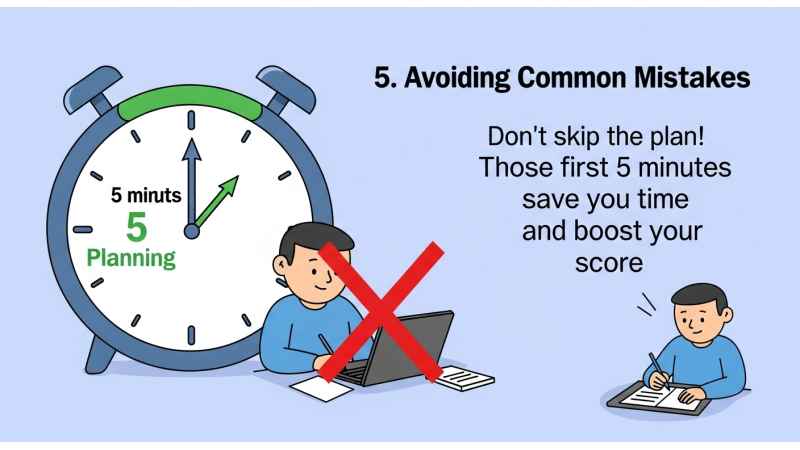
Even when planning, test-takers sometimes slip up. Watch out for these pitfalls:
- Skipping the plan: Some think it wastes time, but writing without a plan leads to a rambling essay. You may go off-topic or leave out a question part. Remember, not planning often results in poor coherence.
- Planning too long: Conversely, don’t spend 10–15 minutes on planning! Keep it around 5 minutes. You need enough time to write and review (about 35–37 minutes for writing plus review).
- Incomplete answers: If the question has two parts (e.g. “Why? What can be done?”), plan to cover both. An answer that ignores part of the prompt will lose Task Achievement marks.
- Vague ideas: Plan clear, specific points. Avoid generalities like “It’s better” without explanation. Make sure each reason has a defined argument and an example.
- Copying the question: Don’t just copy wording from the prompt in your introduction. Always paraphrase or rephrase the question when you note it in your plan. This shows language ability and avoids repetition.
By avoiding these mistakes, your plan will actually help your essay rather than hinder it.
Why 5-Minute Planning Works
Here’s why those 5 minutes are so powerful:
- Saves time overall: With a clear plan, you know what to write next. You won’t freeze up deciding on ideas mid-sentence, so the actual writing goes faster.
- Improves clarity: Planning forces you to order your thoughts. The resulting essay has a logical flow that’s easy for the examiner to follow.
- Keeps you on-topic: A plan is like a road map (see Jacky’s analogy). It stops you from wandering off-topic or repeating yourself.
- Reduces mistakes: When you’re not desperately thinking “what do I say next?”, you can focus on using correct grammar and vocabulary. Plus, having ideas sorted means you’re less likely to add irrelevant points. Overall, a plan means a cleaner, more relevant essay.
In short, good planning frees up your mind to write with confidence. Instead of staring at a blank page, you’ll be writing full sentences from minute one.
Practice Activity
To put this into action, pick an IELTS Task 2 question and try planning under exam conditions. Set a timer for 5 minutes and go through Steps 1–5 without writing the full essay yet. Then use another 35 minutes to write the essay based on your plan.
For example, practice with this question (adapted from IELTS materials):
“Some people believe that children should be taught moral values by parents at home, while others argue that schools should take responsibility for this. Discuss both views and give your opinion.”
- Identify the essay type (Discussion – both views + opinion).
- Decide your position (e.g., children learn best from parents at first, but schools reinforce values).
- Brainstorm two main ideas for each perspective and solutions.
- Outline intro, two bodies, conclusion.
- Jot some keywords (e.g., ethics, family influence, curriculum).
Then write out a full essay. Afterward, compare it to a model answer or check if you covered all points. Regular practice like this will make planning second nature.
Thoughts for Now
To sum up, spending just a few minutes on a clear plan can transform your IELTS Task 2 essay. As one IELTS instructor puts it, an essay’s clarity, structure, and purpose are “all built during planning”. Essays with a solid plan are easier and faster to write, and they score higher for coherence. Practice this 5-minute planning routine and soon it will become automatic – giving you the confidence to write high-band essays within time.

About the AuthorWelcome to TechIELTS. I’m Md. Jahangir Alam, an experienced engineer with over 15 years in electrical and automation systems. Alongside my engineering career, I’ve developed a strong interest in English language learning and IELTS preparation.
I hold a Duolingo English Test score of 135 (IELTS 7.5 equivalent) and am currently pursuing an M.Sc. in Cyber Security from Royal Holloway, University of London. I use my technical background to create clear, structured IELTS learning materials for students and professionals.
👉 Connect on LinkedIn
